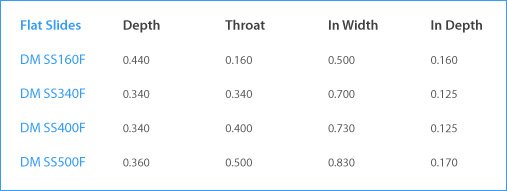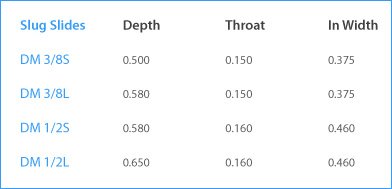Low Friction Mast Cars & Slides
Mainsails that raise and lower easily make sailing much more enjoyable. We offer a range of solutions, from ultra low friction UHMW Track Systems to our Ball Bearing Cars and MDS Nylon Slides. If a main is difficult to raise, the problem often lies with the slides and mast track, particularly with older / painted masts or round slug type slides. However, the masthead sheave, twisted internal halyards, and the turning blocks (if the halyard is led back to the cockpit) will also add friction. With our modular design, all our products are upgradeable, so if the trackless Ball Bearing Cars do not provide enough friction reduction, you can upgrade to our track system. See the Track Brochure for more information on our Track System.
Trackless Ball Bearing Cars
Our compact, ball bearing cars roll against the back of the mast to help eliminate friction. These fittings are offered with tensioners for Full Length Battens, and without tensioners for the intermediate / headboard slide locations, or for sails without full length battens. We have two sizes, the smaller 350 series, and the larger 560 series. The Ball Bearing Wheels roll against the outside rear surface of the mast, taking all the compression loads, and much of the side loads. Since the stainless steel balls inside the nylon ball bearing wheels do not come in contact with the mast, they tend to stay clean and do not jam. The nylon wheels are kind to painted masts.
Full Universal Joint
Cars are connected to the sail with our patented ball and socket universal joint. This prevents the car from jamming in the mast track, and also prevents the battens from developing twists when the sail is down. Our universal joint requires no additional mast offset. This helps keep the cost down by allowing existing connections to be used.
Proven Effective
Over 5,000 sold since 1991. Mr. Charles Kanter, noted multihull expert, wrote in the Practical Sailor that ” After extremely heavy use, I have not had one failure, and have given the slides no maintenance save an annual cleaning of the sail track.” He also notes that our fittings are “refreshingly inexpensive”. Mr. Kanter has cruised for over 5 years, covering several thousand miles on his 32′ catamaran with a 275 square foot main. Our normal 5 year guarantee applies – see guarantee for more details. The Practical Sailor reviewed our smaller, 350 series, and said ” It retains it’s original strengths: simplicity, low cost, light weight, tension adjustments at both the luff and leech.” And; “it does the job of managing full battens neatly and it’s adjustments and ultimate low cost are very endearing qualities. It’s a sensible choice for the budget-conscious owner of a smaller boat.” You must first order the Car Measuring Kit, to determine the correct car and slide combination, and check that the cars roll freely against the mast. Note that the mast must have a reasonably flat aft surface for the car to roll on.
[/panel]
Ball Bearing Cars
In general, Ball Bearing Cars should be used if:
• A track system is too expensive
• You daysail with some coastal cruising
• Mast track is in good condition, not an usual shape, and sail has a large roach
• Sail is raised and lowered from the mast / you can pull down the last few feet
• Estimated friction reduction 50-70% if all attachments use ball bearing cars, 40-60% full battens only get cars
Roller Slides
Roller Slides utilize our MDS (Molybdenum Disulfide) filled nylon slides. Rollers can supplied in different sizes, or custom machined to fit unusual mast shapes.
These slides can be supplied in 3 different configurations. You can purchase the slides individually, and attach them to your sail using 1″ flat webbing. We can also supply them with a universal joint, which simply screws onto your sail. For full length battens, we can supply the slides with a universal joint and a batten tensioner. These fittings work very well, given the moderate price.
Before ordering, you must order the Roller Slide Measuring Kit, to determine the correct car and slide combination, and check that the slides roll freely against the mast.
Note that unusually shaped masts may require custom machined rollers.
Roller Slides should be used in the following applications:
• Ball bearing cars are too expensive
• You primarily are daysailing
• Sail has a small or normal roach main (not much forward thrust)
• Sail is raised and lowered from the mast, and/or mast track is in good shape
• Estimated friction reduction 30-50% if all attachments use Roller Slides, 20-40% full battens only get Roller Slides
MDS Slides
Dutchman Slides utilize MDS (Molybdenum Disulfide) filled nylon for less friction than conventional slides. They are also somewhat longer than conventional slides, which makes them less likely to lock in the mast track from twisting loads.
The Dutchman D160F is designed for Selden / Kemp type masts. To reduce friction and maximizing strength with flat slides, the throat should be as large as possible. This prevents the slide from twisting in the mast track. The throat dimension is the critical dimension with flat slides.
With slug slides, unlike flat slides, there is a large variation of how deeply the slug fits into the mast. For this reason, we offer 3/8” and 1/2” waisted slug slides in two depths to accommodate different mast sections with less binding.


